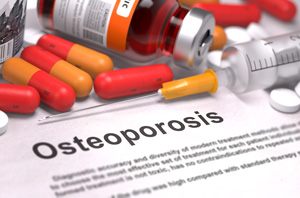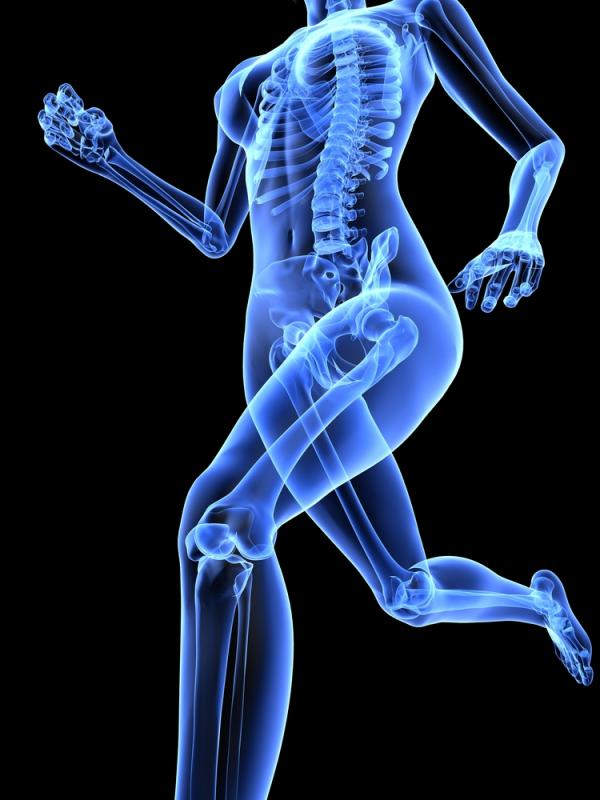Treating osteoporosis
Men and women who are found to have osteoporosis based on a bone density measurement (BDM) may frequently be advised to take treatment in the form of a number of drugs. Effective treatment however is not just based on how well these drugs improve bone density measurement but critically they will also have been shown to reduce fracture rates before they receive a license from European and UK Regulatory Authorities.
Which drugs reduce fracture risk?
 For more than two decades we have known that drugs which reduce the rate of bone breakdown (bone resorption) significantly reduce the likelihood of fractures in the spine, at the hip and for many drugs at other non-spine sites.
For more than two decades we have known that drugs which reduce the rate of bone breakdown (bone resorption) significantly reduce the likelihood of fractures in the spine, at the hip and for many drugs at other non-spine sites.The primary group of drugs used are the bisphosphonates, such as alendronate and risedronate. They are inexpensive and generally safe in the short-term and therefore can be prescribed for anyone with osteoporosis. They are mainly taken as a tablet once a week.
Effervescent Alendronate
For people with swallowing or stomach issues a new type of effervescent form of alendronate (called Binosto®) is now available. A once monthly oral bisphosphonate (ibandronic acid) is also available, but while it reduces spine fractures its effectiveness in preventing fractures at other sites is less clear and it is therefore often considered a second line drug.
Indigestion (or dyspepsia) can occur with all of the oral bisphosphonates and in that case or in the case of people who are unable to comply with the rather complex administration instructions requiring the drugs to be taken in the morning on an empty stomach, injectable drugs are available. Zoledronic acid is given by an intra-venous drip once yearly. A different type of anti-resorptive drug, denosumab, is given by an injection under the skin (sub-cutaneous) every 6 months. Hormone replacement therapy (HRT) is also a valuable treatment, which reduces fractures and is often advised in younger post-menopausal women. See Dr Tania Adib’s article for further information.
Indigestion (or dyspepsia) can occur with all of the oral bisphosphonates and in that case or in the case of people who are unable to comply with the rather complex administration instructions requiring the drugs to be taken in the morning on an empty stomach, injectable drugs are available. Zoledronic acid is given by an intra-venous drip once yearly. A different type of anti-resorptive drug, denosumab, is given by an injection under the skin (sub-cutaneous) every 6 months. Hormone replacement therapy (HRT) is also a valuable treatment, which reduces fractures and is often advised in younger post-menopausal women. See Dr Tania Adib’s article for further information.
Stimulating new bone formation
 Clearly, for people with very severe osteoporosis as diagnosed using dual-energy x-ray (DXA) scanning, the ideal would be not just to prevent bone breakdown, but to also stimulate new bone formation using so-called anabolic drugs. The effectiveness of these treatments can be monitored by a combination of DXA scanning and diagnostic tests involving the new bone turnover markers.
Clearly, for people with very severe osteoporosis as diagnosed using dual-energy x-ray (DXA) scanning, the ideal would be not just to prevent bone breakdown, but to also stimulate new bone formation using so-called anabolic drugs. The effectiveness of these treatments can be monitored by a combination of DXA scanning and diagnostic tests involving the new bone turnover markers.At present only one such drug is readily available, teriparatide, which is given by sub-cutaneous injection daily for up to 2 years. Sadly this therapy is relatively expensive and its use is limited by NICE guidance, meaning that is only available in NHS settings to those people who have failed treatment with the bisphosphonates and have very low bone density, or privately at bone specialist clinics such as 25 Harley Street.
Getting access to latest and best treatments
A new bone anabolic agent, abaloparatide, which has shown excellent anti-fracture effects, is going through the regulatory processes at present and should become available in the next few months although it may be rather expensive for the NHS to allow its use in a widespread fashion. Another, a new anabolic drug called romosozumab, which inhibits the action of sclerostin, a protein that affects the functioning of the bone forming cells also has excellent anti-fracture and bone building effects. It may well become available in the next one to two years but the stipulation of it being affordable for the NHS also applies. Again, proper access to these new treatments will only be fully available via specialist private clinics.
Tailoring effective treatment to individual need
There are some other drugs that reduce bone breakdown and are licensed for osteoporosis in the UK but most osteoporosis experts feel that these are “second-line” and only used when the more potent therapies are contra-indicated or not well tolerated. Raloxifene has some of the characteristics of HRT with beneficial effects on bone without adverse effects on the breast. However, it has rather weak anti-fracture effects at the spine and little effect in preventing limb or hip fractures.
Strontium Ranelate has moderate anti-fracture effects at the spine and hip and may be useful in the elderly but unfortunately it may have negative side effects on heart attacks and blood clots in the leg, so it is very important that those at risk of such events are not prescribed the drug.
What about Calcium and Vitamin D?
The value of a high calcium intake, whether in the form of dietary consumption or supplement, has been recently questioned. It is now considered that an overall intake of 700 grams per day, which can be achieved by a pint of milk (skimmed or semi-skimmed is just as good as whole fat milk) or other calcium containing foods, is all that is required for good bone health and often no calcium supplements are required. This is a change in management advice that has occurred because of some controversial data suggesting that excess calcium consumption can be related to an excess risk of heart attacks or strokes.
 Unlike calcium, the evidence base for the value of vitamin D has hardened in recent years. Adequate vitamin D levels from the diet or by sunlight exposure is hard to achieve especially in the winter months or in those who expose little skin to the sun. Recent nutritional advice in the UK has indicated that many adults may need to take an additional 400 -1000IU of vitamin D from the diet or as a supplement. In addition, vitamin D supplements (often with a little extra calcium) are usually advised to be taken alongside other drugs such as the bisphosphonates, when osteoporosis treatment is required. It is very important that before the injectable drugs mentioned above are used vitamin D levels are restored to normal values to avoid symptomatic low calcium levels (hypocalcaemia).
Unlike calcium, the evidence base for the value of vitamin D has hardened in recent years. Adequate vitamin D levels from the diet or by sunlight exposure is hard to achieve especially in the winter months or in those who expose little skin to the sun. Recent nutritional advice in the UK has indicated that many adults may need to take an additional 400 -1000IU of vitamin D from the diet or as a supplement. In addition, vitamin D supplements (often with a little extra calcium) are usually advised to be taken alongside other drugs such as the bisphosphonates, when osteoporosis treatment is required. It is very important that before the injectable drugs mentioned above are used vitamin D levels are restored to normal values to avoid symptomatic low calcium levels (hypocalcaemia).
 Unlike calcium, the evidence base for the value of vitamin D has hardened in recent years. Adequate vitamin D levels from the diet or by sunlight exposure is hard to achieve especially in the winter months or in those who expose little skin to the sun. Recent nutritional advice in the UK has indicated that many adults may need to take an additional 400 -1000IU of vitamin D from the diet or as a supplement. In addition, vitamin D supplements (often with a little extra calcium) are usually advised to be taken alongside other drugs such as the bisphosphonates, when osteoporosis treatment is required. It is very important that before the injectable drugs mentioned above are used vitamin D levels are restored to normal values to avoid symptomatic low calcium levels (hypocalcaemia).
Unlike calcium, the evidence base for the value of vitamin D has hardened in recent years. Adequate vitamin D levels from the diet or by sunlight exposure is hard to achieve especially in the winter months or in those who expose little skin to the sun. Recent nutritional advice in the UK has indicated that many adults may need to take an additional 400 -1000IU of vitamin D from the diet or as a supplement. In addition, vitamin D supplements (often with a little extra calcium) are usually advised to be taken alongside other drugs such as the bisphosphonates, when osteoporosis treatment is required. It is very important that before the injectable drugs mentioned above are used vitamin D levels are restored to normal values to avoid symptomatic low calcium levels (hypocalcaemia).Long-term risks of osteoporosis treatments
There has been recent anxiety about two particular side-effects that may occur with the bisphosphonates and denosumab. Osteonecrosis of the jaw (ONJ) is a nasty condition that causes difficult to heal deep ulcers in the mouth. It occurs in up to 1 in 25 patients with cancer who receive very much larger doses of the bisphosphonates and denosumab than are used in osteoporosis. It has been estimated that ONJ occurs in only 1 in 10,000 to 1 in 100,000 people taking the drugs in osteoporosis doses.
Thigh Bone Fractures
Atypical Femoral Fractures are unusual breaks in the thigh bone (femur), which often cause pain before the fracture occurs. They are a very rare type of fracture that may account for perhaps 1 in 200 femur fractures. They do become more common in bisphosphonate and denosumab users, especially after several years of use, but the upper estimates of that excess risk maybe only 1 in 800 of hip fractures stopped by bisphosphonates, which is a rather good risk-benefit ratio. Despite the rarity of these 2 conditions osteoporosis experts are now advising a one to two year break from treatment after 5 years of bisphosphonate therapy, depending on the fracture risk at the end of that treatment period.
Overall treatment of osteoporosis reduces fractures by a substantial amount and for anyone with osteoporosis and/or high clinical risk of fracture integrated treatment is highly recommended.
See also food to boost immunity and bone health.
Undesirable side-effects of medication.
Full medical glossary
A class of drugs used in osteoporosis and other bone diseases to reduce loss of bone mass
Full medical glossary
A fluid that transports oxygen and other substances through the body, made up of blood cells suspended in a liquid.
Full medical glossary
An element that forms the structure of bones and teeth and is essential to many of the body's functions.
Full medical glossary
Abnormal, uncontrolled cell division resulting in a malignant tumour that may invade surrounding tissues or spread to distant parts of the body.
Full medical glossary
The basic unit of all living organisms.
Full medical glossary
Blood that has coagulated, that is, has moved from a liquid to a solid state.
Full medical glossary
An abbreviation for diabetes mellitus.
Full medical glossary
A means for the continuous injection into a vein.
Full medical glossary
An abbreviation for dual energy X-ray absorptiometry.
Full medical glossary
The medical term for indigestion.
Full medical glossary
One of the three main food constituents (with carbohydrate and protein), and the main form in which energy is stored in the body.
Full medical glossary
The thigh bone.
Full medical glossary
The basic unit of genetic material carried on chromosomes.
Full medical glossary
The death of a section of heart muscle caused by an interruption in its blood supply. Also called a myocardial infarction.
Full medical glossary
Abbreviation for hormone replacement therapy, the administration of female hormones in cases where they are not sufficiently produced by the body.
Full medical glossary
Prefix suggesting a deficiency, lack of, or small size.
Full medical glossary
An abnormally low level of calcium in the blood. The most common cause is vitamin D deficiency.
Full medical glossary
intermittent claudication
Full medical glossary
Relating to the menopause, the time of a woman’s life when her ovaries stop releasing an egg (ovum) on a monthly cycle.
Full medical glossary
Death of cells or tissue in the body due to disease, injury or impaired blood supply.
Full medical glossary
A condition resulting in brittle bones due to loss of bony tissue.
Full medical glossary
A craving to eat non-food substances such as earth or coal.
Full medical glossary
Compounds that form the structure of muscles and other tissues in the body, as well as comprising enzymes and hormones.
Full medical glossary
the organ or the body where food is stored and broken down
Full medical glossary
Any sudden neurological problem caused by a bleed or a clot in a blood vessel.
Full medical glossary
Any abnormal break in the epithelium, the outer layer of cells covering the open surfaces of the body.
Full medical glossary
Relating to the veins.
Full medical glossary
Essential substances that cannot be produced by the body and so must be acquired from the diet.
Full medical glossary








